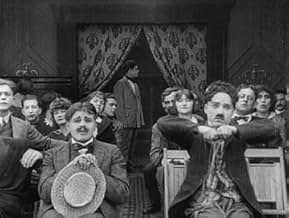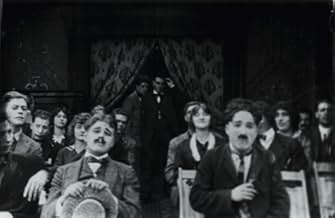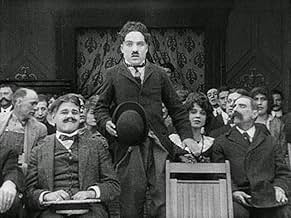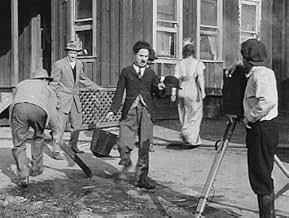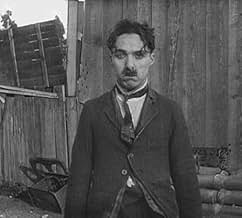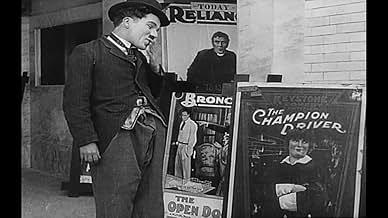IMDb रेटिंग
5.6/10
1.8 हज़ार
आपकी रेटिंग
अपनी भाषा में प्लॉट जोड़ेंCharlie attempts to meet his favorite movie actress at the Keystone Studio, but does not win friends there.Charlie attempts to meet his favorite movie actress at the Keystone Studio, but does not win friends there.Charlie attempts to meet his favorite movie actress at the Keystone Studio, but does not win friends there.
- निर्देशक
- लेखक
- स्टार
Dan Albert
- Audience Member
- (बिना क्रेडिट के)
Hampton Del Ruth
- Lead Actor
- (बिना क्रेडिट के)
Minta Durfee
- Self
- (बिना क्रेडिट के)
- …
Billy Gilbert
- Theatre Usher
- (बिना क्रेडिट के)
William Hauber
- Audience Member
- (बिना क्रेडिट के)
Bert Hunn
- Audience Member
- (बिना क्रेडिट के)
George Jeske
- Prop Boy in White Shirt
- (बिना क्रेडिट के)
Edgar Kennedy
- Director
- (बिना क्रेडिट के)
Sadie Lampe
- Audience Member
- (बिना क्रेडिट के)
Henry Lehrman
- Self
- (बिना क्रेडिट के)
Hank Mann
- Prop Boy in Overalls
- (बिना क्रेडिट के)
Harry McCoy
- Fireman
- (बिना क्रेडिट के)
- …
George Nichols
- Older Actor on Screen
- (बिना क्रेडिट के)
फ़ीचर्ड समीक्षाएं
The film was produced in March 1914, during the post-Mabel's Strange Predicament period when Mabel Normand was still refusing to work with Chaplin (Mack Sennett's autobiography). Sennett, however, managed to get Mabel into the film by displaying a poster depicting her as a champion racing driver. Chaplin is meant to fall in love with her image, but note that he takes the opportunity to disrespect the Keystone Girl by mocking her dirty, oily face. This is probably the film where new-boy Chaplin later says he had an angry confrontation with director 'Pops' Nichols. Long-serving Popsie almost had a seizure when the ranting Charlie told the old guy he knew nothing about directing pictures!
In any event, the warring pair managed to finish the movie, which has a weak story-line, but gives Sennett an advertising opportunity for Keystone. Charlie goes on to create uproar in the picture house when he sits on Mrs Arbuckle's lap, and overdoes the emotional stakes when Keystone's Peggy Pearce appears on screen.
Having been thrown out of the picture-house, Charlie decides to get down to the Keystone studios and meet the stars. He appears at Keystone as car loads of the company arrive, including Fatty Arbuckle from who he begs a dime. Minta Arbuckle merely laughs at the tramp- like Charlie, who she later described as being dirty and smelly. Incidentally the studio is not the real lot, and the set appears to be among some very upper-crust accommodation indeed. It is in fact the swanky Bryson Apartments on Wilshire Boulevard! After being told 'No bums here' by director Edgar Kennedy, Charlie forces his way into the studio, and who should he see on the set but the Keystone girl to die for – Peggy Pearce. Following attempts to force himself on Peggy and interfere with the action, Charlie acquires a revolver and begins to shoot up the set, sending the cast diving for cover. Our tramp now leaves the studio, slams the door behind him, and gives the aging doorman a swift kick.
A house fire occurring in the vicinity, sends the cast racing off in the Keystone cars, in order to obtain some 'atmosphere' for their film. For some unexplained reason, crazy Charlie is already on his way to the scene, and running down the middle of Wilshire Boulevard (or is it Broadway?). When Charlie reaches the fire (which appears to be in dusty old Edendale) he finds the film crew already setting up for a scene in which Peggy Pearce is being roughed up. The gallant tramp intervenes and incurs the wrath of the studio men, one of whom tries to brain him with a plank. When Charlie attempts to abduct Peggy, she responds by giving the tramp a good whipping.
According to Sennett, Chaplin had no designs on any of the Keystone starlets, and no success with women in general during 1914. He was right about the second part, but Charlie made amorous advances to both Peggy Pearce and Mabel Normand. Both were eventually to reject the 'lovable genius of a problem child' (as Mary Pickford called Chaplin). Several of Chaplin's sworn enemies are in this picture, including Pathe Lehrman and Pops Nichols. Everyone made representations to Sennett that Chaplin was impossible to work with, but Lehrman also said that Chaplin was in love with Mabel, and that Mabel was having various affairs (including, somewhat later, with Valentino). How did Sennett respond? He took the Tramp and the Jazz Babe out to dinner every night – what better way of keeping an eye on the recalcitrant pair.
In any event, the warring pair managed to finish the movie, which has a weak story-line, but gives Sennett an advertising opportunity for Keystone. Charlie goes on to create uproar in the picture house when he sits on Mrs Arbuckle's lap, and overdoes the emotional stakes when Keystone's Peggy Pearce appears on screen.
Having been thrown out of the picture-house, Charlie decides to get down to the Keystone studios and meet the stars. He appears at Keystone as car loads of the company arrive, including Fatty Arbuckle from who he begs a dime. Minta Arbuckle merely laughs at the tramp- like Charlie, who she later described as being dirty and smelly. Incidentally the studio is not the real lot, and the set appears to be among some very upper-crust accommodation indeed. It is in fact the swanky Bryson Apartments on Wilshire Boulevard! After being told 'No bums here' by director Edgar Kennedy, Charlie forces his way into the studio, and who should he see on the set but the Keystone girl to die for – Peggy Pearce. Following attempts to force himself on Peggy and interfere with the action, Charlie acquires a revolver and begins to shoot up the set, sending the cast diving for cover. Our tramp now leaves the studio, slams the door behind him, and gives the aging doorman a swift kick.
A house fire occurring in the vicinity, sends the cast racing off in the Keystone cars, in order to obtain some 'atmosphere' for their film. For some unexplained reason, crazy Charlie is already on his way to the scene, and running down the middle of Wilshire Boulevard (or is it Broadway?). When Charlie reaches the fire (which appears to be in dusty old Edendale) he finds the film crew already setting up for a scene in which Peggy Pearce is being roughed up. The gallant tramp intervenes and incurs the wrath of the studio men, one of whom tries to brain him with a plank. When Charlie attempts to abduct Peggy, she responds by giving the tramp a good whipping.
According to Sennett, Chaplin had no designs on any of the Keystone starlets, and no success with women in general during 1914. He was right about the second part, but Charlie made amorous advances to both Peggy Pearce and Mabel Normand. Both were eventually to reject the 'lovable genius of a problem child' (as Mary Pickford called Chaplin). Several of Chaplin's sworn enemies are in this picture, including Pathe Lehrman and Pops Nichols. Everyone made representations to Sennett that Chaplin was impossible to work with, but Lehrman also said that Chaplin was in love with Mabel, and that Mabel was having various affairs (including, somewhat later, with Valentino). How did Sennett respond? He took the Tramp and the Jazz Babe out to dinner every night – what better way of keeping an eye on the recalcitrant pair.
Am a big fan of Charlie Chaplin, have been for over a decade now. Many films and shorts of his are very good to masterpiece, and like many others consider him a comedy genius and one of film's most important and influential directors.
He did do better than 'A Film Johnnie', still made very early on in his career where he was still finding his feet and not fully formed what he became famous for. Can understand why the Keystone period suffered from not being as best remembered or highly remembered than his later efforts, but they are mainly decent and important in their own right. 'A Film Johnnie' is a long way from a career high, but has a lot of nice things about it.
'A Film Johnnie' is not as hilarious, charming or touching as his later work and some other shorts in the same period. The story is flimsy and the production values not as audacious. Occasionally, things feel a little scrappy and confused.
For someone who was still relatively new to the film industry and had literally just moved on from their stage background, 'A Film Johnnie' is not bad at all.
While not audacious, the film hardly looks ugly, is more than competently directed and is appealingly played. Chaplin looks comfortable for so early on and shows his stage expertise while opening it up that it doesn't become stagy or repetitive shtick. The Tramp did become more likeable later but again he was still evolving.
Although the humour, charm and emotion was done even better and became more refined later, 'A Film Johnnie' is humorous, sweet and easy to like, though the emotion is not quite there. It moves quickly and doesn't feel too long or short.
Overall, far from one of Chaplin's best but pretty good and perhaps one of his better efforts from the early Keystone period. 7/10 Bethany Cox
He did do better than 'A Film Johnnie', still made very early on in his career where he was still finding his feet and not fully formed what he became famous for. Can understand why the Keystone period suffered from not being as best remembered or highly remembered than his later efforts, but they are mainly decent and important in their own right. 'A Film Johnnie' is a long way from a career high, but has a lot of nice things about it.
'A Film Johnnie' is not as hilarious, charming or touching as his later work and some other shorts in the same period. The story is flimsy and the production values not as audacious. Occasionally, things feel a little scrappy and confused.
For someone who was still relatively new to the film industry and had literally just moved on from their stage background, 'A Film Johnnie' is not bad at all.
While not audacious, the film hardly looks ugly, is more than competently directed and is appealingly played. Chaplin looks comfortable for so early on and shows his stage expertise while opening it up that it doesn't become stagy or repetitive shtick. The Tramp did become more likeable later but again he was still evolving.
Although the humour, charm and emotion was done even better and became more refined later, 'A Film Johnnie' is humorous, sweet and easy to like, though the emotion is not quite there. It moves quickly and doesn't feel too long or short.
Overall, far from one of Chaplin's best but pretty good and perhaps one of his better efforts from the early Keystone period. 7/10 Bethany Cox
I love these early short comedies from Chaplin because, much more than most other directors early in their career, these early short films are such clear depictions of reality, there is always so much history to be seen in them. In Film Johnny, Charlie plays himself, basically, a newcomer to film, trying to get into the pictures and get noticed. But of course, in true Chaplin form, the only thing he manages to do is create havoc, botch an unnecessary rescue attempt and a make a mess of the studio.
My understanding is that "film Johnny" refers to the guys that would hang around film studios, hoping to get inside and get a job (it should be noted that Steven Spielberg used to do this). Chaplin starts out in this film as one of those guys, and then we see a clear escalation of the gags that they put together, culminating in a priceless scene where he gets his hands on a gun and gives in to the feeling of power and invincibility it gives him, and he goes around shooting up the place, famously lighting a cigarette by shooting it with the gun and then firing shots at random around the studio, eventually catching it on fire and inadvertently providing the perfect ending for the film that they had been trying to shoot while he was messing everything up.
It is also interesting, as I have noticed some other IMDb users have pointed out, that in this film you get a glimpse of the Keystone Studios lot only weeks after Chaplin began his film career. A must see for any fan.
My understanding is that "film Johnny" refers to the guys that would hang around film studios, hoping to get inside and get a job (it should be noted that Steven Spielberg used to do this). Chaplin starts out in this film as one of those guys, and then we see a clear escalation of the gags that they put together, culminating in a priceless scene where he gets his hands on a gun and gives in to the feeling of power and invincibility it gives him, and he goes around shooting up the place, famously lighting a cigarette by shooting it with the gun and then firing shots at random around the studio, eventually catching it on fire and inadvertently providing the perfect ending for the film that they had been trying to shoot while he was messing everything up.
It is also interesting, as I have noticed some other IMDb users have pointed out, that in this film you get a glimpse of the Keystone Studios lot only weeks after Chaplin began his film career. A must see for any fan.
Film Johnnie, A (1914)
** (out of 4)
Charles Chaplin plays a film buff who goes to Keystone Studios to meet his favorite stars, which he does but at the same time he doesn't find himself welcomed after a while. Roscoe 'Fatty' Arbuckle, Virginia Kirtley, Mabel Normand and Ford Sterling are among the stars seen at the studio and while this it's fun to see all these stars together I wouldn't go further by calling this a good movie. Chaplin is quite animated here as he finds himself getting into one mess after another, which eventually leads to his setting a set on fire. Some historians seem to think that this movie was a way for the studio to display their feelings towards Chaplin. It was well known that he was causing trouble with his attitude even this early in his career so historians believe the annoying character here is the studio showing him as he was. I'm not sure how true this is but it's an interesting theory.
** (out of 4)
Charles Chaplin plays a film buff who goes to Keystone Studios to meet his favorite stars, which he does but at the same time he doesn't find himself welcomed after a while. Roscoe 'Fatty' Arbuckle, Virginia Kirtley, Mabel Normand and Ford Sterling are among the stars seen at the studio and while this it's fun to see all these stars together I wouldn't go further by calling this a good movie. Chaplin is quite animated here as he finds himself getting into one mess after another, which eventually leads to his setting a set on fire. Some historians seem to think that this movie was a way for the studio to display their feelings towards Chaplin. It was well known that he was causing trouble with his attitude even this early in his career so historians believe the annoying character here is the studio showing him as he was. I'm not sure how true this is but it's an interesting theory.
Shot very early in Chaplin's film career, A Film Johnny (I have no idea what the title means) is a short, but fascinating look at how movies were made in the earliest days of Hollywood.
Unfortunately, the DVD version I saw was a 1930s reissue edit that, for some reason, omits the prologue in which Chaplin decides to visit a movie studio after falling for a girl on the screen. But what remains is a fast-paced, sometimes confusing montage of scenes in which the Little Tramp (fast developing into the character the world would come to love) basically causes havoc at the real-life Keystone Studios.
Reportedly, Mack Sennett and Fatty Arbuckle and even Mabel Normand appear in the film. I think I spotted Sennett, but I have no idea what role Arbuckle played, while Normand was nowhere to be seen (though she might be the girl seen laughing at Charlie at the end). But as I saw a shortened version, it's possible their scenes were simply cut out.
What does survive is a very funny (and innovative) gag in which Chaplin lights a cigarette by firing a gun loaded with blanks at it. That, plus a fleeting glimpse of the Keystone Studios mere weeks after Chaplin began his movie career, makes this worthwhile. Chaplin's later film, Behind the Screen, another movie lot comedy, is a much better film, however.
Unfortunately, the DVD version I saw was a 1930s reissue edit that, for some reason, omits the prologue in which Chaplin decides to visit a movie studio after falling for a girl on the screen. But what remains is a fast-paced, sometimes confusing montage of scenes in which the Little Tramp (fast developing into the character the world would come to love) basically causes havoc at the real-life Keystone Studios.
Reportedly, Mack Sennett and Fatty Arbuckle and even Mabel Normand appear in the film. I think I spotted Sennett, but I have no idea what role Arbuckle played, while Normand was nowhere to be seen (though she might be the girl seen laughing at Charlie at the end). But as I saw a shortened version, it's possible their scenes were simply cut out.
What does survive is a very funny (and innovative) gag in which Chaplin lights a cigarette by firing a gun loaded with blanks at it. That, plus a fleeting glimpse of the Keystone Studios mere weeks after Chaplin began his movie career, makes this worthwhile. Chaplin's later film, Behind the Screen, another movie lot comedy, is a much better film, however.
क्या आपको पता है
- ट्रिवियाAlthough some sources credit Mack Sennett with playing himself, the film director, the role is actually played by Edgar Kennedy--who, besides being a comic actor, was also a respected director.
- गूफ़Members of the audience behind Charlie Chaplin change - for example, Minta Durfee is sitting behind Chaplin in some shots, but a different actress is seated behind him in others.
- इसके अलावा अन्य वर्जन1930s reissue version, entitled Film Johnny, (released on DVD) omits the opening sequence in the movie theater.
- कनेक्शनFeatured in Crazy Days (1962)
टॉप पसंद
रेटिंग देने के लिए साइन-इन करें और वैयक्तिकृत सुझावों के लिए वॉचलिस्ट करें
विवरण
- रिलीज़ की तारीख़
- कंट्री ऑफ़ ओरिजिन
- आधिकारिक साइटें
- भाषाएं
- इस रूप में भी जाना जाता है
- Charlie the Actor
- फ़िल्माने की जगहें
- उत्पादन कंपनी
- IMDbPro पर और कंपनी क्रेडिट देखें
- चलने की अवधि
- 15 मि
- रंग
- ध्वनि मिश्रण
- पक्ष अनुपात
- 1.33 : 1
इस पेज में योगदान दें
किसी बदलाव का सुझाव दें या अनुपलब्ध कॉन्टेंट जोड़ें

